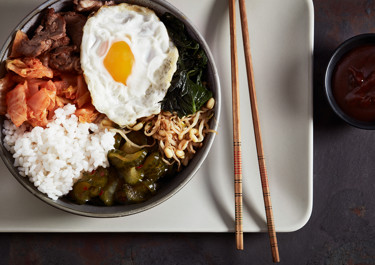Bibimbap
&format=webp)
Bibimbap is a favourite from Korean street food cuisine. It consists of a rice base with a combination of other ingredients like sirloin steak and kimchi. Making bibimbap at home can be easy, just follow this recipe. If you can't find gochujang, you can use another chilli sauce that you like.
Ingredients
Marinated meat
|
400 g
Sirloin steaks, thinly sliced
|
|
|---|---|
|
2 tbsp
Japanese soya sauce
|
|
|
1 tbsp
Icing sugar
|
|
|
2
Garlic cloves
|
|
|
1 tbsp
Sesame oil
|
Marinated spinach
|
65 g
Baby spinach
|
|
|---|---|
|
3
Green onions
|
|
|
1 tbsp
Japanese soya sauce
|
|
|
1 tbsp
Sesame oil
|
|
|
1 tbsp
Sesame seeds
|
Marinated bean sprouts
|
150 g
Bean sprouts
|
|
|---|---|
|
1 handful
Fresh coriander
|
|
|
1 tsp
Salt
|
|
|
1 tbsp
Sesame seeds
|
|
|
1 tbsp
Sesame oil
|
Chilli-pickled cucumber
|
1
Cucumber
|
|
|---|---|
|
25 g
Icing sugar
|
|
|
¼ dl
Vinegar (12%)
|
|
|
1 tbsp
Sambal oelek
|
Serve with
|
250 g
Short-grain Rice
|
|
|---|---|
|
2 tbsp
Butter and rapeseed oil
|
|
|
200 ml
Kimchi
|
|
|
4
Eggs
|
|
|
4 tbsp
Gochujang
|
Instructions
Marinated sirloin
Marinated spinach
Marinated bean sprouts
Chilli-pickled cucumber
For serving
The best drinks for bibimbap
From a wine perspective, pair your dinner with a full-bodied and slightly sweet Riesling. If you prefer to keep it traditional, serve with a Korean beer or makkoli, a lightly sparkling and opaque wine made from fermented rice and wheat.
Questions about bibimbap
Are you supposed to shake bibimbap?
Unlike Bond's martini, bibimbap is best stirred, not shaken. Once you have your bowl in front of you, you can either mix the ingredients together into one single dish, or keep them separate and experiment with different combinations for each bite.
Should bibimbap be eaten hot or cold?
Either or. In Korea, it's not uncommon to enjoy a cold bibimbap in summer, and hot version in winter. Give both a try and see which one is your favourite!
Do you need a stone bowl for bibimbap?
In Korea, you will often find this dish served in a stone bowl that has enough room to easily mix the ingredients into a harmonious meal, but any deep bowl will do. A less-traditional alternative is to serve the ingredients buffet style and let guests build their own bibimbap in bowls or plates.
Is the egg in bibimbap raw?
A traditional bibimbap is topped with a sunny-side-up egg where the whites are cooked through, but the yolk is runny.
A Korean street food staple
While the exact origin of bibimbap is unknown, reference to the dish can be found as far back as the 1500s. Today, it is one of Korea's most celebrated dishes with strong cultural roots and can be found in many restaurants, home kitchens and street corners across the country. Its global popularity is partly thanks to Korean Air when it included bibimbap on its in-flight menu in 1997.
The philosophy behind bibimbap
Said to symbolise harmony and balance, this dish is apparently a combination of the five colours of health: the dark ingredients pays homage to the north and foods that benefit the kidneys. Red and orange welcomes the south to the bowl and focuses on heart health. Green is for the east and optimal liver function. White represents the west and strong lungs, while the yellow egg serves as the centre and promotes a healthy stomach.
Spice it up or veg it out
Adding extra spice to your bibimbap is as easy as spooning extra gochujang into your bowl. Fresh chillies will also add an extra kick to your meal, as will a dash of Korean chilli oil. Swapping the meat for marinated mushrooms is also highly recommended and a great vegetarian option that will convert even the most devoted carnivore.








